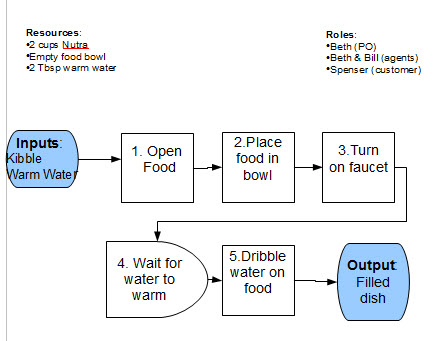A very Simple Process Model
“If you cannot define what you are doing as a process, you do not understand what you are doing.” -- W. Edwards Deming

Above is a model of a fairly simple process. It is a fairly high-level model; the model could easily contain more detail. There is no absolute right or wrong in the level of detail that is placed in a process model. This model could have 100 steps or more if we were exhaustive in detailing the process. The correct level of detail depends on the purpose of the model and what we wish to use the model to analyze.
The goal of the above process is to produce a filled bowl of food for Spenser, the family dog. I guess the ultimate goal is a well-fed, healthy dog.
Process outputs can be inputs to other processes. We won’t go into detail examining the processes for which this is an input.
Processes are initiated in response to triggers. The trigger for the ‘Feed Spenser’ process is time of day. If this trigger is ignored by the agent responsible for carrying out the process, there are back-up triggers. The first is that Spenser gets off his couch and stares at the responsible agent. This escalates into mild groaning. The final emergency warning trigger to initiate the process is a single full scale bark.
The inputs to this simple process are 2 cups of Nutra dog food, an empty bowl and 2 Tablespoons of warm water.
Process, Procedures, Work Instructions
The process, as documented, has 4 activity steps. Each of these steps can be thought of as a procedure- or as a separate process.
In other words, we could take each of the activity steps and break it down in further, closer detail- treating it as its own process.
E.g. – Activity step 2: Place food in bowl. This could potentially be broken down into:
2.1 Grab scoop
2.2 Reach scoop into food bag
2.3 Fill scoop
2.4 Remove filled scoop from bag
2.5 Empty scoop into bowl
As stated above, there is no absolute right or wrong on the level of detail- it depends on the purpose of the model. It is useful however to make a mental distinction between processes, procedures and work instructions.
Process models look at an overall process, at whatever appropriate level of organizational abstraction. They provide a high level view, appropriate to examine a process in its entirety.
Procedures are subsets of a process; though they can also be thought of as stand-alone processes. They break parts of a process down into greater detail.
Work instructions are the lowest level of documentation. They
provide the step by step instructions necessary for the minimally
trained to carry out the activity steps of a procedure. Work
instructions often focus on the point at which the process meets
enabling technology (aka software) and include step by step
documentation on how to use tools to carry out a procedure.

